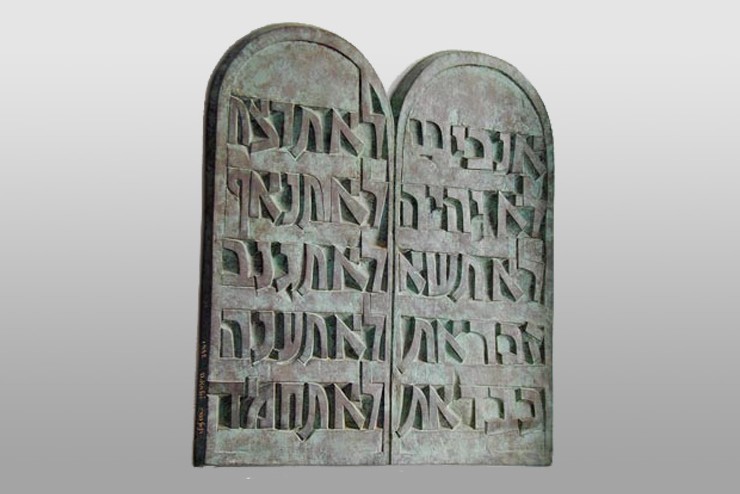These days, with my hectic schedule, I find that I do almost all of my shopping via catalogs, but over this past Passover I actually had a chance to go shopping in a real live store.
The man who was helping me told me that I should wish him a zissen Pesach, a happy Passover, because he was Jewish.
As we got to talking he told me that he had just celebrated his fiftieth wedding anniversary and for the occasion, he and his wife had another wedding ceremony. He told me all about it and then told me about something that I found very strange.
 It seems that there are Judaica artists that are doing something new. They ask the bride and groom to gather the pieces of the glass that is broken under the chuppah (wedding canopy) and save them. The artist takes all of the pieces and encases them in a beautiful glass cube and inscribes the names of the bride and groom and the wedding date on the piece as a memento of the occasion.
It seems that there are Judaica artists that are doing something new. They ask the bride and groom to gather the pieces of the glass that is broken under the chuppah (wedding canopy) and save them. The artist takes all of the pieces and encases them in a beautiful glass cube and inscribes the names of the bride and groom and the wedding date on the piece as a memento of the occasion.
The salesman was very excited about this new art form, but as I left the store, I told my wife, “I don’t really understand why anyone would want such a thing.” I like the idea of keeping the wine glasses used at your wedding, but why keep the broken glass? Why remember it?
And the truth is that we have to ask the same question about the holiday of Shavuot.
Let me explain.
The anticipation that surrounds Shavuot in many ways is like no other holiday. We literally count down the days from Pesach and the leaving of Egypt, to our becoming true servants of God by receiving the Torah on Mt. Sinai. Shavuot commemorates the highest moment of the history of the Jews, the wedding between the Jewish people and God.
The wedding canopy, Mount Sinai, was smoking; there was fire and the sounding of the shofar. It was there that God gave the ketubah, the marriage contract, over to the Jewish people—the Torah. This is the beautiful and transcendent moment that we remember on Shavuot.
But look what happens so soon afterwards: the Jewish people rebel by deifying the golden calf. Moses reacts. The Torah tells us, (Exodus 32:19) “And it came to pass when he (Moses) came near unto the camp and saw the calf and dancing–then Moses’ anger waxed hot and he cast the tablets out of his joined hands and smashed them beneath the Mount.” Moshe took this most precious gift and, and on the seventeenth of Tammuz of that year, destroyed it.
In the next chapter of the Torah we read about the second giving of the tablets. In Exodus 34:1, God said to Moses, “Hew for yourself two tablets of stone like the first ones; and I will write on the tablets the words which were on the first tablets that you broke”. So Moses did it and Moses once
again had the two tablets. The tablets were in the hands of Moses on the tenth of Tishrei, the day of Yom Kippur.
So, Luchot It was on Yom Kippur that the permanent tablets were finally in Moshe’s hands and in the hands of the Jewish people for generations to come.
Shouldn’t we celebrate the giving of the Torah on Yom Kippur instead?
The answer comes by way of a tradition that tells us that when the Jews transported the tablets in the tabernacle, they not only carried around the intact tablets. They also took the shattered pieces of the original tablets everywhere they went. They did so in order to remind themselves of their past. The broken tablets were not only there to act as a reminder of the event of the golden calf, but more important, they were there to integrate that past experience into their lives. The goal was to integrate the memory
to a point at which the Jewish people could not only remember it, but use it for increased learning, increased awareness of themselves and, most importantly increased connection to God.
This is the message of celebrating the giving of the Torah on Shavuot even though the first giving turned out to be a disappointment for the Jewish people and for God. In our personal lives, it is tempting for all of us to think about broken experiences and want to throw them away. It is tempting to want to completely forget the leaving of a great job, the ending of a close relationship or a death of a loved one.
Among the many lessons of Shavuot, is not to do that. Shavuot teaches us that we can use events that have ended in heartbreak and keep them alive in order to learn from our past and blend it in to make our lives more worthwhile. Shavuot teaches us not to forget our past, but to use our past to make our present lives more valuable.
So now I understand the value of this new trend of Jewish art that my nice Jewish salesman shared with me. I wish I had saved the pieces from the broken glass at my wedding. I would put them right next to our other wine cups because preserving the pieces of the broken glass helps us to imitate the actions of the Jewish people in the desert — to keep the fragments and to blend them into not only our national religious psyche, but into our personal ones as well.